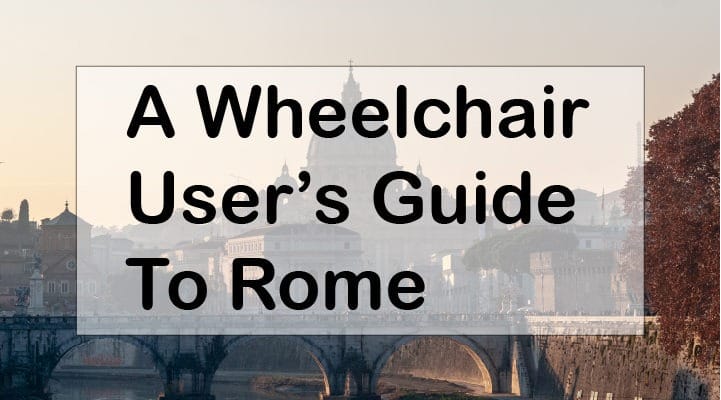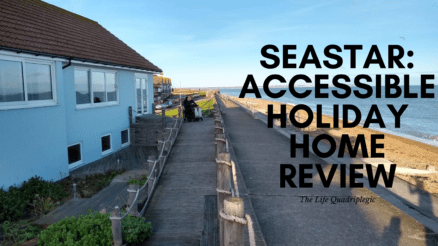Last Updated on 17/11/2019 by Alex Squire
I’ll tell you this upfront: Rome is not one of the most accessible cities in Europe. But it is definitely one of the most fascinating.
If you like history then this is the place to come – just brace yourself for the cobblestones.
Getting there
I used Disabled Access Holidays for this trip who booked the flights, the hotel, transfers, and equipment for me. I flew from East Midlands airport to Ciampino with my 2 carers. A wheelchair accessible van picked me up at the airport and took me to the hotel.
Accommodation
I stayed in the Best Western Plus Hotel Universo. This 4-star hotel is in the centre of Rome and is a five-minute walk from Termini station – the main train station.
Wheelchair access inside the hotel was good. The hotel had steps down to the restaurant but ramps were provided, so no problem. My carers found the ramps a bit steep though and required a decent run up to push me up them (I was in a manual chair).
My room was spacious and had an accessible bathroom with a decent roll in shower. At first sight what appeared to be a double bed, thankfully, turned out to be 2 single beds joined together. My carer and I didn’t fancy sharing a bed!


I had hired a mobile hoist and commode shower chair which were waiting in the hotel when I arrived. The concierge brought them both up to my room.
I must say that all the hotel staff were very friendly and helpful. The concierge was happy to book taxis for us.
Getting around town
For wheelchair users, there are a number of accessible options for getting around Rome. You can either roll, take the Metro, the tram, a bus, or a taxi.
Most of the time we walked/rolled around Rome. Quite a few of the main attractions are within walking distance of each other. But to be honest I didn’t find strolling around very pleasant due to the cobblestones, uneven pavement, bumping up and down curbs, and the amount of exhaust fumes. So in hindsight, I wish we’d used public transport more.
Rome has 2 Metro lines A and B. Not all of the Metro stations have disabled access but I found a page that gives you a list of stations which are accessible. I used the Metro on one occasion to get back from Vatican City. The nearest station was Ottaviano and it had a platform lift going down a flight of stairs. A member of staff came out to operate it for me. We took the metro back to Termini station which has good access and is near my hotel.

There is a taxi company called Cooperativa Radiotaxi 3570. They have a number of accessible vehicles and one day we used one to get to the Capitoline Museum. The vehicle was similar to accessible taxis I have used in England and was just about big enough for my manual chair.
There are a number of accessible hop on/hop off sightseeing buses that stop at the main attractions. I used one to get to Vatican City on one occasion but it was quite expensive so I didn’t do it again.

I didn’t use any of the normal buses or trams so I can’t comment on these.
The sights
There is a lot to see in Rome which is packed full of historical treasures. Below are some of my favourites, which are all possible to see in a wheelchair.
St Peter’s Square
St Peter’s Square is directly in front of St Peter’s Basilica and is surrounded by columns with an Egyptian obelisk in the centre. Again cobblestones are covering the square but it is an impressive area and a good place to get some photos with the obelisk or St Peter’s Basilica behind you.

I recommend avoiding St Peter’s Square on Wednesdays because this is when the Pope gives his weekly address (Unless you desperately want to see the Pope of course.) It gets extremely busy and it will probably be a nightmare for wheelchair users.
St Peter’s Basilica

St Peter’s Basilica is the largest, and probably most opulent, church in the world.
To get into the basilica you have to cross St Peter’s Square and go through airport-like security. The queues to enter the basilica stretched right across the square, but wheelchair users get to skip the line and get free entry. See this page for accessibility information.

The basilica is full of impressive statues, paintings, and carvings with smooth marble floors. It’s easy to roll around inside.
It’s possible to go onto the roof of the basilica via a lift. Wheelchair users might find the sloped roof a bit problematic. I couldn’t see much over the side because there were fences and statues in the way. Able-bodied people could go up the dome but you have to use the stairs so it’s not accessible.
They did have a disabled toilet on the roof which was pleasing. I can now say I have peed on the roof of the largest church in the world.
Vatican Museums

The Vatican museums house a huge collection of artefacts. The main entrance has steps up to it but there is another accessible entrance.
I visited on a Friday evening to try and avoid the crowds. Normally the Vatican is open from 9 AM to 4 PM. But for a number of months, it also opens on Friday evenings from 7 PM to 11 PM.
We saw the Sistine Chapel first and then made our way through the rest of the museums. The main entrance of the chapel is up a number of steps so wheelchair users have to go in via an accessible side entrance. I was led by a member of staff through a narrow passageway and down a platform lift to the chapel.

It is definitely worth going to see the Sistine Chapel. It was beautiful. There are vibrant paintings everywhere you look and it truly is a sight to behold. You can’t take photos in the Sistine Chapel, so I can’t share any. You will have to go and see it for yourself.
The museums were still busy in the evening. When I got to the Raphael room it was absolutely packed and I had to go back out because it was hard to move. I hate to imagine what it would be like during the day when most people go.
I guess the Vatican museums will be crowded whatever time you go but in the evenings it probably is a bit better. But the accessibility of them is good with an accessible entrance and lifts to every floor. Also disabled people and one carer get in free, but you can’t book your visit online. You just have to speak to someone at reception when you arrive.
There’s some decent accessibility information about the Vatican museums on this page.
Colosseum

The Colosseum, or the Flavian amphitheatre as it was originally known, is a must-see in Rome. Around the outside of the Colosseum there are quite a lot of cobbles, as there are in many places in Rome. Inside the Colosseum on the ground floor the surface is smooth.
There is a lift that goes up to the middle tier of the Colosseum. The lift is manned so only people that really need it can use it, which is good to see. It’s not possible for wheelchair users to go the upper tiers or underground levels though.

There is an exhibition about Roman society and culture on the middle floor which was interesting. Plus there were a number of busts and artefacts to view.
I was happy to find a disabled toilet on the ground floor. But I had to go past a long line of people waiting to get into the adjacent toilets to get to the disabled one. They could probably do with more toilets.
It’s good that they have made an effort to make the Colosseum as accessible as it can be for wheelchair users. Adding a lift is probably not an easy thing to do in a building that is over 2000 years old, but they have done it – so Kudos to them.
Pantheon

The pantheon is an old Roman temple which used to be dedicated to the pagan gods. Its name literally means “all the gods”. But it was eventually converted into a church and all the traces of pagan religion were removed.
Again Cobblestones cover the square in front of the Pantheon, so it’s a bumpy approach. You need to go up a ramp to get into the pantheon. A member of staff was quick to direct me to where the ramp was.

Staff at the attractions in Rome were always eager to help and quick to direct wheelchairs to where we needed to go. Most of the time we didn’t even have to ask.
Inside the Pantheon, it is spacious with flat marble floors. Sunlight enters through a big hole in the roof, called an oculus. Even with quite a few people inside the pantheon, there was still a good amount of room to move around.
Trevi Fountain
The Trevi Fountain is the largest Fountain in Rome and was designed by Nicola Salvi in 1762. It stands 26.3 m high and 49 m wide, so it’s anything but subtle.

The Fountain takes up the vast majority of the square that it sits in and is surrounded on all sides by buildings. It was very crowded when I went to see it so I couldn’t get right up next to the water and it was hard to get an unobstructed view.

But I could see all the carvings and statues above the water. There was also a step to get down right next to the Fountain which also doesn’t help wheelchair users.
Vittorio Emmanuelle II Monument

This huge white marble monstrosity is a monument to the first king of unified Italy Vittorio Emmanuelle II. The locals have a number of names for it including “the wedding cake”, “the false teeth”, and the “typewriter.” I don’t think they like it much.
A large number of steps lead up the front of the monument. But inside the monument, there is a lift. The accessible entrance is around the side and one of the guards can take you to lift. I barely fit in this lift in my manual chair, but I did manage it.

The internal lift takes you about halfway up the monument where there is a flat area where you can look out over the city. Unfortunately, on this level I couldn’t see over the balustrade around the edge. So all I got was a nice view of the marble. It is nice marble…but after a while gets a bit boring.
There is another lift which you can take to go all the way to the top. This is a glass elevator called Rome from the Sky which you have to pay €10 to use. Disabled people get to go free with one carer.

On the top, the view over the city is the best you can get in Rome. It’s fantastic. There are glass barriers around the edge so my view wasn’t obstructed. You can see many of Rome’s most famous buildings, like the Colosseum, the forum, the pantheon, and many more. There is a board that labels them to help you find them.

If you want to get a good view over Rome then this is the place to come, and it’s accessible – as long as you can fit in the lift that is.

Pompeii
I decided to take a little break from Rome one day and go on a trip to Pompeii. To get there we had to go on the train.
The ruins themselves are fascinating, although unfortunately only a relatively small proportion of the site is accessible. There is an accessible route marked on a map we got from the tourist information centre.

The roads of Pompeii consisted of large boulders which are very uneven. It seems that for all their ingenuity the ancient Romans just weren’t able to make flat roads. I’m sure it wouldn’t have been beyond their capability, but there we are.

There are pathways at the side which are relatively flat and there are some large stepping stones in the middle-of-the-road over which pedestrians can cross. They have added a metal pathway to make the stepping stones accessible to wheelchairs.

I also went in the amphitheatre. The entrance is down a relatively steep sloped tunnel with uneven stone slabs. The inside of the amphitheatre has gravel which was quite deep in places and it made pushing the wheelchair very difficult. Getting back out the amphitheatre is even more difficult as you have to go up an uneven slope.

It’s good that they have made an effort to make Pompeii as accessible as they can but obviously there is a limit with what they can do. I wouldn’t want them to destroy the authenticity of the site to make it more accessible. This page gives more information about an accessible path around Pompeii.

The next time I go to Pompeii I will probably make use of the wheely Trekky offered by Rome and Italy tours. This is a contraption that looks like a cross between a wheelbarrow and a wheelchair. It has one large wheel and a seat with one person at the front pulling it along, and one at the back pushing. It’s apparently able to easily go over rough ground so it enables disabled people to access areas that ordinary wheelchairs wouldn’t be able to go to.
It might cost quite a bit, but I think using the wheely Trekky is going to be the only way I can see more of Pompeii.

Capitoline Museum
The Capitoline Museums are the world’s oldest public museums dating from 1471. We had to go up a winding and sloping road to get to the museum on the top of Capitoline Hill.

On the top is Piazza del Campidoglio, a square around which the museums are situated. In the middle is a statue of the Roman emperor Marcus Aurelius on horseback. This is a replica with the original being inside the Capitoline Museum.

To get into the Capitoline Museum we asked one of the staff who led us to a side door which had a ramp up to it. This page has a map and some useful information about access to the Capitoline museums.

The museum has lots of interesting exhibits such as paintings, statues, and carvings. It is an interesting museum to visit and well worth it.
Piazzas
Rome has lots of squares called piazzas, not to be confused with pizzas (although there are lots of those too).

Some of the more famous ones are Piazza Navona, where there is a famous Fountain by Bernini called the Fountain of the four rivers, and Piazza del Popolo which has an obelisk in the middle and some interesting churches nearby.

Piazza Venezia is next to the Palazzo Venezia where you can see the balcony where Mussolini declared war in 1940.

Most of the piazzas are cobbled but they are quite nice to visit and hang out in, and there are often interesting buildings to see nearby.
Wheelchair problems
Halfway through the week one of the casters on my wheelchair seized up. The right wheel wouldn’t turn and so the chair kept pulling over to the right. It made it very difficult to push. I believe this was caused by the constant battering it took from the cobblestones, as well as bumping up and down curbs.
This happened 2 days before we were meant to go to Pompeii, so we were starting to panic a little bit. We’d already bought the train tickets at that point. What would happen if we couldn’t move the chair at all?
Later that evening we were sat outside an Irish pub (of all places) in Trastevere and my carer spoke to one of the locals. He took us to a garage just around the corner where one of the mechanics had a look at my wheel and tightened it up with a spanner.
This seemed to fix the problem, albeit temporarily. The next day it started to seize up again, so then we went to a bike shop. We worked out that we needed a specific type of nut that the bike shop didn’t have. We went to a hardware store nearby, bought one, and my carer fitted it on to my chair with a spanner. This seemed to do the trick and it wasn’t a problem after that.
So, the moral of the story is beware of the cobblestones. Take tools with you so that you can fix any problems that might arise. If you can use a free wheel I would urge you to do so. The Free Wheel wouldn’t fit my type of chair which was frustrating as it would have been very useful. If you do end up having wheelchair problems then I recommend going to a bike shop to see if they can help.
Final thoughts
I enjoyed visiting the sites in Rome, although I didn’t enjoy strolling through the streets because of the constant bumping around. Rome is definitely not one of the most wheelchair accessible cities in Europe. But I do think it is worth visiting because it has so much history.
If you enjoyed this post please sign up to my mailing list to stay up-to-date with new posts 🙂






Brilliant !!
Thanks Karen 🙂
Thanks for sharing. Nicely written.
Thanks Cynthia. I hope you found it useful 🙂
Thank you so much for this.
My stepfather recently suffered a spinal cord injury and is now paraplegic.
My mother has always dreamed of going to Rome, I think your experiences will definitely make their trip a lot more enjoyable and convenient.
You are welcome Erik! I hope this article helps, and I hope that your mother and stepfather have a great trip to Rome sometime 🙂
Thank you for sharing this valuable info. I don’t use a wheelchair currently, but I do have limited mobility stemming from 3 spinal surgeries. I really appreciate your insight. And ugh, cobblestones!! I have hyper mobile joints and this darn things are always threatening to roll my ankles. Still, it’s worth it to get a glimpse of all this history.
Alex thank you so much for the insight. I’m, Valencia from Louisiana and honestly hearing your story is very inspiring. In other words, not letting your disability stop you from enjoying life is amazing. My mother has been paralyzed since she was 45 years of age from a stroke and now 69 i enjoy sharing your story with her because a lot of times, she thinks that she can’t do nothing like that because of her wheelchair. It took me 23 years to convince her to go inside the movie theater with me and she enjoyed it and now all she looks for is her next favorite Dc Movie coming out. I been working on trying to get her to go on a cruise or a trip like this. So, I literally showed her your pic to inspire her Wish me luck and again thank you for inspiring me. Will update on our adventures.
hi Valencia, thanks for your comment. I’m happy that you find my story inspiring. I hope that you manage to convince your mother to go travellingt, there are lots of interesting accessible places that wheelchair users can go. I was going to go on a cruise in 2020. It was all booked but then Covid happened and it got cancelled. I need to book agan sometime! It will be great to hear about your adventures! I wish you the best of luck 🙂